

GMO conspiracy theories - Page 9. Theography: Sketches of Spiritual Truths for a New Evangelization: Human Love in the Divine Plan. An Organic Farmer Walks Into Monsanto…And This is What Happened. By Rob Wallbridge, Songberry Farm, Bristol, QC.
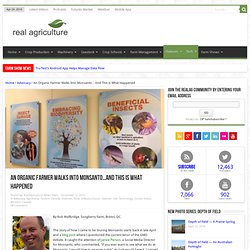
The story of how I came to be touring Monsanto starts back in late April and a blog post where I questioned the current tenor of the GMO debate. It caught the attention of Janice Person, a Social Media Director for Monsanto, who commented, “if you ever want to see what we do at Monsanto, I would love to arrange a visit.” As luck would have it, I passed through St. Louis on the first of August, and Janice was true to her word, arranging for a personal guided tour of their research facility. It’s probably fair to say that both Janice and I experienced some trepidation as the date approached. I’d say that I arrived open-minded but skeptical.
Reading the Seed The first thing I’ll say is that it’s very difficult for someone with an interest in agriculture, and especially seeds, not to be impressed with the scope, power, and potential of the research taking place at Monsanto. Technology Racing the Bugs Seeking Acceptance. From Anti-GMO to pro-science: ‘A Layman’s Guide to GMOs’
The Lowdown on GMOs: According to Science —a book by Fourat Janabi. The Lowdown on GMOs: According to Science —a book by Fourat Janabi. Bad science in the paper ‘Hematotoxicity of Bacillus thuringiensis as Spore-crystal Strains Cry1Aa, Cry1Ab, Cry1Ac or Cry2Aa in Swiss Albino Mice’ By: Myles Power Edited by: Peter & Hannah I have recently published an article and video sceptical of the paper ‘Long-term Toxicity of a Roundup Herbicide and a Roundup-Tolerant Genetically Modified Maize‘.

This paper claims to have shown a link between genetically modified (GM) maize tolerant to the roundup herbicide and an increased risk of developing tumours. Even though I discussed the problems with the paper’s experiment in detail, how the paper did not show any such link but did show a link between drinking roundup herbicide and increased life expectancy in men, and listed reliable sources to back up my claims, some people were still not happy with me. Not with what I was saying, but, bizarrely, with the time of the publication. “haha haha why don’t you analyze the newest studies myles, why don’t you analyze the studies that sparked entire nations to ban GMOs?” So if the paper does not investigate GM food, what does it investigate, I hear you ask. Is glyphosate toxic to humans? Wheat being harvested.
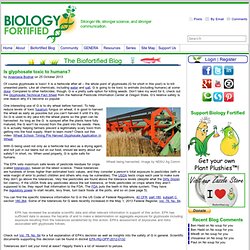
Image by NDSU Ag Comm. One interesting use of G is to dry wheat before harvest. To help reduce levels of toxic fusarium fungus on wheat, it is good to harvest the wheat as early as possible but you can’t harvest it until it’s dry. So G is used to dry (aka kill) the wheat plants so the grain can be harvested. As long as the G is sprayed after the plants have fully matured, the G won’t be moved from the plant into the seeds. EU Database of Reference Methods for GMO Analysis - Joint Research Centre (JRC), European Commission. With 2000+ global studies confirming safety, GM foods among most analyzed subjects in science.
All GM Foods Are Not Created Equal. The Skeptic’s Guide to the Universe is a podcast that I enjoy every week.

This week, the panel discussed the topic of GM foods; and while I don’t disagree with anything they said, I did have to grit my teeth a little during the segment. In engaging the topic the way they did, they fell into the anti-GMO activist’s trap of viewing GM foods as one huge, monolithic group. This drives me nuts. All GM foods are not created equal, and when skeptics engage anti-GMO activists as if they are, they let the anti-GMO crowd frame the debate.
A collection of case studies, tools, knowledge, experiences, and research outputs by Jose Falck-Zepeda, colleagues at IFPRI and the Program for Biosafety Systems (PBS), and developing/developed country partne. My second edited IFPRI book of the year is just around the corner!!! “GMO crops in Africa – Economic and policy lessons for countries South of the Sahara. The IFPRI book “GMO crops in Africa – Economic and policy lessons for countries South of the Sahara” edited by José Falck-Zepeda, Guillaume Gruere and Idah Sithole-Niang will be available for free at IFPRI’s site within a few weeks from now.
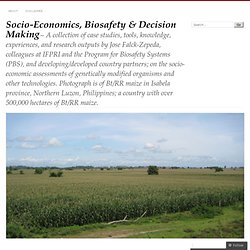
I will let you know as soon as I have a link. Here are some general lessons learned as described in the book: Opportunities for African Farmers South of the Sahara. Farming a Toxin To Protect Crops, Pollinators and People. The familiar teardrop eggplant, with its deep purple luster, is but one member of a large and diverse botanical family.
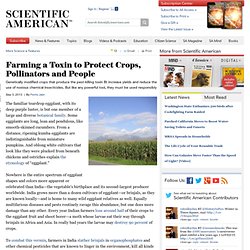
Some eggplants are long, lean and pendulous, like smooth-skinned cucumbers. Global Regulation of GMO Crops. Bringing a new GMO to market involves extensive safety and environmental reviews by regulatory bodies around the world.
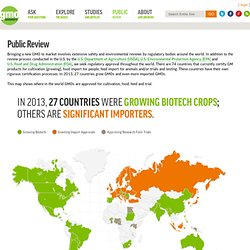
In addition to the review process conducted in the U.S. by the U.S. Department of Agriculture (USDA), U.S. Environmental Protection Agency (EPA) and U.S. Food and Drug Administration (FDA), we seek regulatory approval throughout the world. What is a GMO? An introduction. How do I know which foods don’t contain GMO ingredients?
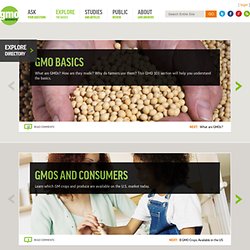
Products with the “USDA Organic” label are required by law not to use GMOs in their food production. Some companies also voluntarily label products as “non-GMO.” There is a current and voluntary system for retailers to designate GMO and organic produce. SKU Produce Look-Ups or PLUs that start with the number 8 designate GM produce and with the number 9 organic produce. This system was developed by the Produce Marketing Association. Produce Marketing Association: The Truth About GMOs. Mama Moses has been growing bananas on her farm in southwestern Uganda for twenty years.

She farms only bananas, which is typical of subsistence farmers in Sanga, the impoverished village where she lives. Last year, when she saw the flowers on her banana plants begin to shrivel and yellow bacteria ooze from the cut stems, she knew her crop was doomed. Within months the bacterial infection turned her healthy crop into a black, wilted mess. The Truth About GMOs. GLP Infographic: 10 reasons we need crop biotechnology. Effect of Stacked Insecticidal Cry Proteins from Maize Pollen on Nurse Bees (Apis mellifera carnica) and Their Gut Bacteria. Honey bee pollination is a key ecosystem service to nature and agriculture.
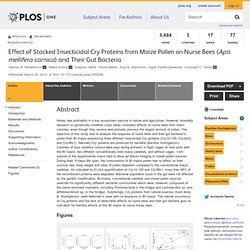
However, biosafety research on genetically modified crops rarely considers effects on nurse bees from intact colonies, even though they receive and primarily process the largest amount of pollen. Stakeholder Consultation on Animal Feeding Studies and in-vitro Studies. GRACE evaluates various types of animal feeding studies and alternative methods (in-vitro and in silico studies) to determine their suitability for human health risk assessments of GM food and feed.
The first stakeholder workshop in Vienna (3-4 December 2012) focused particularly on 90-day animal feeding trials. GRACE partners and representatives from competent authorities, civil society organizations and industry discussed draft plans for the design, conduct and analysis of such studies. Alexander J. Stein. See on Scoop.it - Ag Biotech News Protecting wildlife while feeding a world population predicted to reach 9 billion by 2050 will require a holistic approach to conservation that considers human-altered landscapes such as farmland, according to Stanford researchers. Wildlife and the natural habitat that supports it might be an increasingly scarce commodity in a world where at least three-quarters of the land surface is directly affected by humans and the rest is vulnerable to human-caused impacts such as climate change. But what if altered agricultural landscapes could play vital roles in nurturing wildlife populations while also feeding an ever-growing human population?
A new study… finds that a long-accepted theory used to estimate extinction rates, predict ecological risk and make conservation policy recommendations is overly pessimistic. GRACE FP7. French Anti-Biotech Protests Achieve A Glorious State of Sheer Lunacy. The fallacy of natural food: “Waiter, there’s a gene in my soup!” Results of a 13 week safety assurance study with rats fed grain from glyphosate tolerant corn. A 104-Week Feeding Study of Genetically Modified Soybeans in F344 Rats. A 52-Week Feeding Study of Genetically Modified Soybeans in F344 Rats. Landes Bioscience. Anti-GM corn study reconsidered: Séralini finally responds to torrent of criticism. Types of Pesticides. University student scientist view of crop biotech safety critics: Where’s the beef? History of Agricultural Biotechnology: How Crop Development has Evolved. Mutations (Figure 2) are changes in the genetic makeup of a plant.
Mutations occur naturally and sometimes result in the development of new beneficial traits. In 1940, plant breeders learned that they could make mutations happen faster with a process called mutagenesis. Radiation or chemicals are used to change the plant's DNA, the basic molecular system of all organisms' genetic material.
The goal is to cause changes in the sequence of the base pairs of DNA, which provide biochemical instructions for the development of plants. Genetic Literacy Project. I Love Monsanto! GenPeace: Failure to demonstrate any harm from Cry proteins on mice: comments on Mezzomo et al., 2013. The B. thuringiensis spore crystal (source: reference at the end of the post) Bélin Mezzomo and collaborators from the Department of Genetics and Morphology, Institute of Biological Sciences, University of Brasilia, Brasilia/DF, Brazil, have recently published a paper entitled “Hematotoxicity of Bacillus thuringiensis as Spore-crystal Strains Cry1Aa, Cry1Ab, Cry1Ac or Cry2Aa in Swiss Albino Mice”.
The paper lacks important controls and uses very large spore concentrations in a force-feeding experiment using mice. Some comments on the paper can be found below, as well as a link to the paper: Initial comment. Nematode 18S rRNA gene is a reliable tool for environmental biosafety assessment of transgenic banana in confined field trials - Online First. Information on relatedness in nematodes is commonly obtained by DNA sequencing of the ribosomal internal transcribed spacer region. However, the level of diversity at this locus is often insufficient for reliable species differentiation.
Recent findings suggest that the sequences of a fragment of the small subunit nuclear ribosomal DNA (18S rRNA or SSU), identify genera of soil nematodes and can also distinguish between species in some cases. A database of soil nematode genera in a Ugandan soil was developed using 18S rRNA sequences of individual nematodes from a GM banana confined field trial site at the National Agricultural Research Laboratories, Kawanda in Uganda. The trial was planted to evaluate transgenic bananas for resistance to black Sigatoka disease. Biotech Traits. Genetic engineering is a method, not a product, which means that there are many possible traits far beyond the well-known Bt and Roundup Ready.
Guest Post: Why I’m Through with Organic Farming « Random Rationality. Current Biology - The psychology of GMO. KC - CropBiotech Update - Special Edition (5/8/2013) Scientific American WorldView, an online publication on Global Biotechnology Perspective published on April 24, 2013 featured three prominent agbiotech experts who have been actively involved in addressing global hunger crisis through biotech, in their own unique ways. Authored by Elizabeth Waltz, the three experts named were Dr. Specials : Nature. Time to call out the anti-GMO conspiracy theory. Mark Lynas speech hosted by the International Programs – College of Agriculture and Life Sciences (50th Anniversary Celebration) , and the Atkinson Center for a Sustainable Future, Cornell University 29 April 2013, 2.15pm ET I think the controversy over GMOs represents one of the greatest science communications failures of the past half-century.
Millions, possibly billions, of people have come to believe what is essentially a conspiracy theory, generating fear and misunderstanding about a whole class of technologies on an unprecedentedly global scale. This matters enormously because these technologies – in particular the various uses of molecular biology to enhance plant breeding potential – are clearly some of our most important tools for addressing food security and future environmental change. The Muddled Debate About Pesticide Use And GM Crops. Are widespread among pollinating insects in general. ABC Australia TV radio transcript shows the factors expanding the environmental impact of organic farming approaches (video at Link) Highly contagious honey bee virus transmitted by mites - News releases - News.
Researchers at the University of Sheffield have discovered a parasitic mite has caused the Deformed Wing Virus to proliferate in honey bee colonies. Researchers: Honeybee deaths linked to seed insecticide exposure. WEST LAFAYETTE, Ind. - Honeybee populations have been in serious decline for years, and Purdue University scientists may have identified one of the factors that cause bee deaths around agricultural fields. Critiques envers Séralini. GMOs Are A Pesticide Sponge And Other Weird Tales Of Gilles-Eric Seralini. Food and Chemical Toxicology - Long term toxicity of a Roundup herbicide and a Roundup-tolerant genetically modified maize. Monsanto's GM Corn And Cancer In Rats: Real Scientists Deeply Unimpressed. Politics Not Science Perhaps?
Impact of Genetically Engineered Crops on Farm Sustainability in the United States. Since genetically engineered (GE) crops were introduced in 1996, their use in the United States has grown rapidly, accounting for 80-90 percent of soybean, corn, and cotton acreage in 2009. To date, crops with traits that provide resistance to some herbicides and to specific insect pests have benefited adopting farmers by reducing crop losses to insect damage, by increasing flexibility in time management, and by facilitating the use of more environmentally friendly pesticides and tillage practices.
However, excessive reliance on a single technology combined with a lack of diverse farming practices could undermine the economic and environmental gains from these GE crops. Information Systems for Biotechnology News Report. Apr0803.pdf (application/pdf Object) Extra2.pdf (application/pdf Object) A Rebuttal : Collide-a-Scape. Economic impacts and impact dynamics of Bt (Bacillus thuringiensis) cotton in India.
12(2): Bt Cotton in India: Development of Benefits and the Role of Government Seed Price Interventions. Sterile pest could do away with Bt cotton in Arizona. What's New? - ICGEB. Starved for Science : How Biotechnology Is Being Kept Out of Africa. GMO Pundit a.k.a. David Tribe. Alexander J. Stein - Bringing light in the discussion about GMOs? Alexander J. Stein - Just a short bibliography on farmer suicides in... Genetic Roulette – Section 1. Look Beyond the Scientific Veneer of a GMO Report : Collide-a-Scape. Genetic Roulette.
The likelihood of pollen from GE cotton causing harm to the environment is about as likely as a poodle escaping into the wild – Tomorrow's Table. GM Food And Urban Myths.